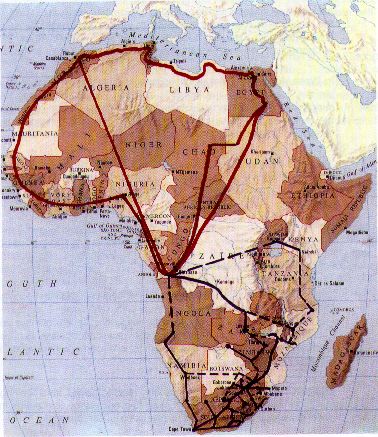|
Africa continent extends from about
the Latitude 35 north of the
equator to about the latitude
35 south of the equator. Whenever
the electric power systems in
Africa are interconnected, the
resulting system would enjoy
the advantage of exchanging
the winter season peak and the
summer season peak across the
electricity networks. Africa
also extends from east to west
within four time zones, thus
would enjoy the diversity of
the daily maximum demand whenever
the power systems are interconnected.
At the extreme north, are the Mediterranean
countries of Egypt, Libya, Tunisia,
Algeria and Morocco. Existing, planned
and possibilities of interconnecting
their power systems have been discussed
in another section.
The main power system in the south
is that of the Republic of South
Africa. The high voltage transmission
system includes sub-systems
with nominal voltage levels
of 132 kV, 220 kV, 400 kV alternating
current and also at +,- 533
kV direct current. The South
Africa Electric Utility (ESKOM)
exports power to Mozambique,
Zimbabwe, Botswana, Namibia,
Lesotho and Swaziland.

Pan-Africa Interconnection
Other transmission systems in southern
Africa which cross the international
boundaries include a 132 kV line
from Cahora Bassa hydro-electric
station in Mozambique to South Africa
and a transmission line from Inga
hydro-electric station in Zaire
to Zambia.
Potentials at Inga falls on the Zaire River
can generate 40000 MW with damming
the river and could be extended
to the order of 100 000 MW.
Plans are being studied to construct
a transmission line which will
run southwards to Angola then
connect to the network of Namibia
which is, in turn, connected
to the network of the Republic
of South Africa. Visions for
a southern African power grid
also extend to include eastern
and western Africa. In the east,
interconnection between Mozambique,
Tanzania and Kenya is a possibility.
In West Africa, the hydroelectric
power of Inga falls in Zaire
could be tapped off via the
transmission line which is planned
to go northwards to Morocco,
to supply the West African countries.
These include Gabon, and Cameroon,
then the region from Nigeria
to the Ivory Coast. This transmission
system could also be tapped
to supply the countries in the
far west up to Mauritania.
The Inga hydroelectric power plant
would thus be the main source of
power which is common to the power
network in southern Africa and to
the power network of northern Africa.
A pan Africa power network would
thus be established.
|
